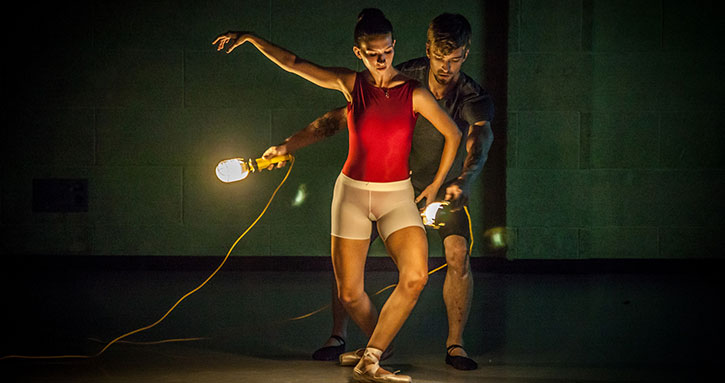An Interview with 2014 Fall Dance Concert Choreographer Adam Hougland
Choreographer of "Cigarettes" and "To the Fore" talks career transitions and inspirations

Dance writer Danielle Georgiou interviewed the three choreographers of the 2014 Fall Dance Concert for a story in the Dallas Observer. The full Q&A is posted below, with permission of theObserver.
Q: As the principal choreographer for the Louisville Ballet and resident choreographer for the Cincinnati Ballet, how do you balance your work here in Texas with your other responsibilities?
A: Louisville and Cincinnati usually only have me in once a year. I normally spend about a month in either place creating something new, or if it’s a re-staging, I might only be there for a couple of weeks. Sometimes, for example this season, I’m not doing anything in Louisville because there is a new artistic director and he is having to plan the last program of the season at the last minute and I’ve already committed to other things. SMU has been great about being really flexible with me, and we try to find ways that I can be here as much as possible but still do my outside projects. Things are always being planned a year if not more in advance, which is sometimes really hard to wrap my brain around, but in the end it makes things less stressful.
Q: Was there a pivotal moment in your career when the transition from dancer to choreographer occurred? What motivated the career shift?
A: Well, it really happened just a year out of Juilliard for me. My senior year there I choreographed a piece for my “senior project” that was a really big hit. The director of the Dance Division decided he wanted to put it on the main stage concert for the following year. So less than a year out of school my piece was performed with an orchestra in Lincoln Center and several directors of regional ballet companies contacted me shortly after that. All of a sudden I was working all over the place. I was still dancing for the Limon Company at the time, but it was clear to me that I needed make the most of the buzz that was building and focus on just choreographing.
Q: What are you most inspired by when you are creating work?
A: Music usually inspires me the most. But I love theater and film. My mom is an actor, director and professor of theater so I grew up seeing a lot. I don’t get to the movies as much as I would like, but they are still a constant source of inspiration. I don’t typically make works with a strict narrative, but there is always some kind of dramatic arc.
Dancers are people in my work, not sculpture.
Q: You are restaging two pieces of your choreography, To the Fore and Cigarettes. What made you choose these two pieces for this show?
A: Well, I wanted to do something on pointe for our strong ballet women. To the Fore was created for the Cincinnati Ballet. It’s quite technical but also very grounded and sensual. It’s nice to give them an opportunity to explore dancing on pointe without any of the delicate ballerina stuff going on. Cigarettes is not at all a ballet, but it was originally made on classical dancers. I like it because it has a playfulness about it, but there is some real tenderness underneath. Both pieces are less than 15 minutes, so I thought it would be a great chance to sandwich both of them together, really just so more people got to work with me.
Q: What can we expect from the works?
A: I think they are both pretty straightforward. The first is really just 101 uses for a light bulb and then the second is six versions of the same song. There is an understated sense of playfulness in both pieces. I guess I’m just trying to say that we don’t always have to be so heavy or serious as artists or in life.
Q: As a Visiting Artist-in-Residence and now choreographer for your students, how has your experience at SMU been so far?
A: I always love teaching and choreographing on the students here. They are so smart, focused and eager to improve and develop themselves as artists. Working with them in technique class and then in my choreography as well enables them to find the connections and dances more technically in my work and to approach ballet class with a more free, movement-based sensibility. I look forward to my time at SMU every year, and each time I come back I see more and more that we are building on what we worked on the last time rather than starting from square one. This enables me to push them even more with their training and ask even more of them in the creative process.
SEE MORE: An Interview with "Dancin' Man" Choreographer Alexander Sanchez